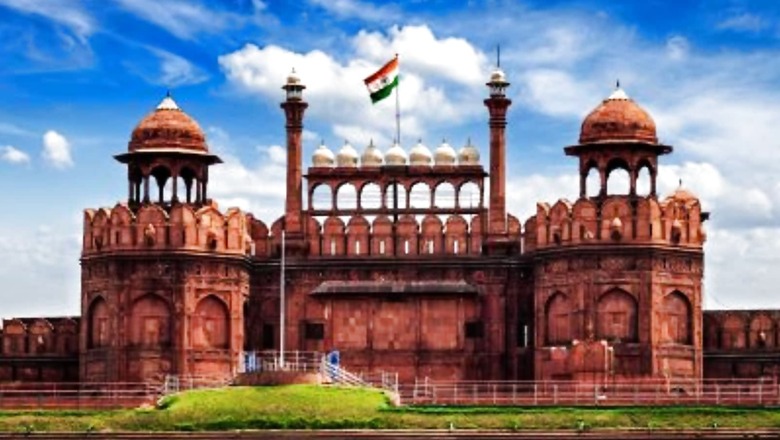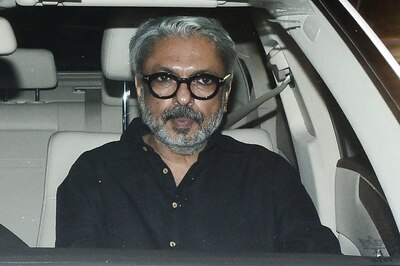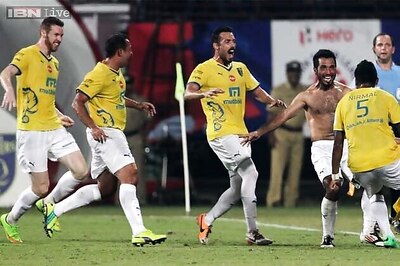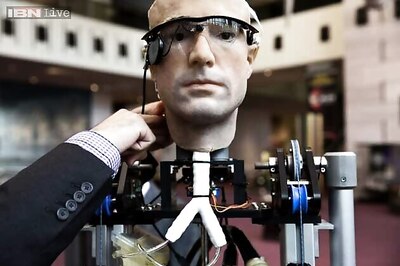
views
Speaking from the Red Fort on August 16, 1947, Jawaharlal Nehru declared that India ‘has achieved freedom under the brilliant leadership and guidance of Mahatma Gandhi.’ Despite the colossal greatness of the Mahatma, the statement was inaccurate and an oversimplification. Yet, the myth that was created by India’s first prime minister 75 years ago remains the official myth of India to this day.
The fact is that the only Gandhian movement nearly a decade after the Civil Disobedience Movement was snuffed out at the planning stage and thereafter there was no Gandhian movement. If anything troubled the British government, it was the impact of the INA trials.
When the Indian National Army (INA) or the Azad Hind Fauj ravaged by the monsoon, destroyed by diseases due to lack of food, medicine, clothing and transport fought valiantly against vastly better armed and supplied Allied armies in the Arakan and Imphal campaigns, next to nothing was known about it in India. The British government had blacked out all information on Subhas Chandra Bose and the Fauj in the Indian press.
The existence of the Fauj was officially announced in early May 1945 after the war ended in Europe and the Japanese army and the INA were on the retreat in Burma (now Myanmar). Highlighting the ‘evil genius of Bose’, the war correspondent of the Sydney Morning Herald reported from Calcutta that it was ‘not yet permissible to give the full details of the Indian National Army’. The INA story ‘has been one of the most closely censored episodes of the war’, commented the Amrita Bazar Patrika, and added that ‘Subhas Chandra Bose’s name was rarely allowed to be mentioned in the Indian press but his broadcasts were known to have been listened to by many Indians’. The government authorities felt that disclosing that Indians were fighting on the side of the Japanese would dishearten Indian soldiers fighting on the Allied side because of their fear that they would be shooting at their own people. It was also argued that disclosure of the fact that Indians had taken up arms against the Empire would create a bad global impression.
Although the story of the INA was now out in public domain, there was not yet any reaction from the Indian political parties. A public statement from Jawaharlal Nehru would appear in the press only on August 17.
The convenient narrative of the INA being an army formed under coercion, from which soldiers were deserting in large numbers, soon received a jolt. Inconvenient questions regarding the army’s status soon came to the fore. The AP war correspondent reported from Rangoon, ‘while it is true that majority of the army is composed of prisoners of war, most of whom probably joined under some form of duress or coercion, there is a considerable number who apparently joined quite freely’.
The British government of India and the Allied army commanders displayed a derisive attitude towards the INA from the very beginning; an attitude that has largely remained in place even today.
The extent of detestation that the British military establishment had towards the INA manifested itself in the memoirs of Francis Tuker, commander of the IV Corps and General Officer Commanding, Eastern Command, India, from January 1946. Vitriol oozed from almost every line he wrote. According to Tuker, the Japanese prisoners of war (POWs) stunk, ‘but at least were neither traitors to us nor to their own people’ and ‘showed themselves the superiors of the cowards and weaklings of the Indian Army we have just seen.’ The INA was ‘feeble, sordid and impotent’.
The fundamental problem was one of conflicting principles. It was a direct confrontation between the points of view of the British, who saw the Fauj soldiers as traitors, and the Indians, for whom these men were patriots. ‘The Indian National Army (INA) had broken their oath of loyalty and had taken part in savage acts against their fellow prisoners of war who refused to fight for the Japanese,’ Louis Mountbatten held on to his point of view as late as in 1968 while delivering the Second Nehru Memorial Lecture.
ALSO READ | Congress Minister Passed on British Intel Reports on Subhas Chandra Bose to Gandhi
As the government decided to go ahead with the trial of the INA soldiers, it became clear that a political volcano was ready to erupt over the trials. Ironically, the INA soldiers were brought to India and put on trial at the very place they had vowed to march into for their victory parade. The idea to make the Red Fort trials the Indian version of Nuremberg and Tokyo trials backfired. Bose’s war was justified. The humiliation of the INA soldiers —Hindu, Muslim, Sikh, Christian — galvanised the Indians like never before since India was brought under direct British government rule. The British were wise enough to see the writing on the wall. The swelling public opinion, manifested in numerous meetings, felicitations of the INA soldiers, fundraising to help their families and rallies in cities, could not be brushed aside.
This was the backdrop against which the Congress party geared to go to the general elections in the winter of 1945-46. It made all the sense for the Congress party to make the best of this opportunity. By September, the censorship had been lifted and the INA saga was becoming known to the people of India for the first time.
Jawaharlal Nehru first expressed his opinion on the INA on August 16, 1945 while speaking at a meeting of Sikhs in Srinagar. He took the line of argument that the soldiers were misguided but their patriotism was unquestionable. ‘I have always considered them misguided people, but have never doubted their patriotism,’ he said. This was the line that was adopted by the Congress too. In other words, the Congress positioned itself as a magnanimous organisation which would support patriots who were ‘mistaken’ in not following the creed of non-violence. Come independence, however, the INA soldiers were dropped like hot potatoes despite the exalted resolutions of the All India Congress Committee (AICC).
The AICC formed an INA Defence Committee comprising Tej Bahadur Sapru, Bhulabhai Desai, K.N. Katju, Jawaharlal Nehru, Raghunandan Saran and Asaf Ali (convener).
Vallabhbhai Patel was more forthcoming in his assessment. Writing to Biswanath Das, who would later become chief minister of Orissa (Odisha), in January 1946, he noted that the benefits accruing to the Congress on account of the INA trials did not mean that the party would yield ground to Subhas Bose or his men. All that was happening was tactical.
Naturally, our efforts have resulted in raising the strength of the Congress … The Congress recognises the sacrifice and bravery of the INA people. That does not mean that the stand their leader took or the policy that the Forward Bloc followed in this country was right. The Congress has never accepted that position nor is there any reason to do so in the future. However, we must, for the time being, be a little more tolerant of their mistaken belief, if any, regarding the so-called justification of their attitude.
Much has been made about Jawaharlal Nehru donning the lawyer’s gown to defend the INA. Dwijendra Nath Bose, Subhas’s nephew, who had been tortured in jail during the freedom movement, was also not impressed with the argument that Nehru had set aside all past acrimony to defend the INA soldiers during the Red Fort trials:
Do you understand the word namavali, which means the words “Hare Krishna Hare Rama” are printed on clothing worn by Brahmins? So, Panditji thought it proper to wear that namavali of INA to cross the river of election.
According to K.K. Ghosh, who was the first to write an authoritative and comprehensive account of the INA in 1960s, the Congress ‘had no political programme ready at hand to rejuvenate’ the dull political atmosphere. As a ‘ready-made issue’ the cause of the INA officers offered the Congress ‘an opportunity to organise an all-India nationalist front against the British’. Another report from the Director of Intelligence at the India Command headquarters noted that the Congress’s general secretary, J.B. Kripilani, said that the Congress sponsoring of the INA was intended for election purposes, and that after the elections, the Congress would drop the matter.
Bhulabhai Desai’s powerful oratory and legal arguments kept the country absorbed with the proceedings. When he met an Indian officer at the Chelmsford Club on November 15, Desai told him that the trials had given the INA their best weapon for propaganda, and the way things were going, it might lead to an armed revolution.
ALSO READ | Netaji Wanted Women to be Trained in Self-defence while Gandhi Insisted on Their ‘Purity’
No one knew India’s internal situation better in those days than the Director of the Intelligence Bureau. Sir Norman Smith noted in a secret report of November 1945:
The situation in respect of the Indian National Army is one which warrants disquiet. There has seldom been a matter which has attracted so much Indian public interest and, it is safe to say, sympathy … the threat to the security of the Indian Army is one which it would be unwise to ignore.
Meetings and processions were organised to observe Azad Hind Day throughout the country after the trials commenced. Between November 21 and 24, serious rioting broke out in Calcutta, followed by riots in Bombay, Karachi, Patna, Allahabad, Banaras, Rawalpindi and other places. Clashes between demonstrators and the police took place in Lucknow, Madurai and Lahore too. Violence erupted in Calcutta when students, after holding a meeting to observe the Azad Hind Fauj Day, took out a procession. In the ensuing clash with the police, three were killed and 58 injured.
Claude Auchinleck, Commander-in-Chief of British Indian Army, was worried. On November 26, he wrote to Archibald Wavell, Viceroy of India:
I do not think any senior British officer today knows what is the real feeling among the Indian ranks regarding the INA. I myself feel, from my own instinct largely, but also from the information I have had from various sources, that there is a growing feeling of sympathy for the INA.
Auchinleck’s observations towards the end of the year showed how unsettling the INA affair had been for the government. In his assessment of the internal situation in India, Auchinleck made the following observations:
… There are now large quantities of unlicensed arms throughout India and there will be many ex-INA men to use them, if they feel so inclined. There will also be a considerable number of ordinary demobilized soldiers in town and villages, many of whom may be persuaded to support Congress. All these men are train(ed) in the use of weapons, and members of the INA have some training in the technique of anti-British leadership….
… It can be concluded, therefore, that if and when trouble comes it may be on a greater scale than in August 1942…Also there will be more arms and more men trained in their use at the disposal of the forces of disorder, and the disruption of communications is likely to be designed to isolate and gain control of large tracts…
The nationalist fervour in the country had reached such levels by that time that it erased the differences between the Hindus and the Muslims. The New York Times reported on February 17, 1946:
In spite of the uncompromising struggle between the two factions, last week for the first time since 1921, Moslems and Hindus together staged street protests and riot against the British in Calcutta, Bombay and New Delhi. The catalytic agent in this case was the Indian National Army, organised by a Japanese collaborator named Subhas Chandra Bose.
In London, a number of perceptive British MPs met prime minister Clement Attlee on February 13, 1946 to give their frank reading of the situation. Among the observations and suggestions by the MPs were:
There are two alternative ways of meeting this common desire (a) that we should arrange to get out, (b) that we should wait to be driven out…
The British government was moving fast to execute its assurances on transfer of power. On January 14, 1946, a meeting of the India and Burma Committee chaired by Attlee decided to send a mission of three cabinet ministers to India towards the end of March, when the results of the elections would be fully known. The Cabinet Mission, comprising Pethick-Lawrence, Stafford Cripps and A.V. Alexander, was formally announced in the House of Commons and the House of Lords on February 19, 1946.
ALSO READ | Inconvenient Nationalist, Not Nazi Lover: Looking at Subhas Bose without Colonial Glasses
Fresh trouble had started just the day before when ratings of The Royal Indian Navy (RIN) in Bombay rose in revolt, starting with a strike at HMIS Talwar. The immediate triggers were bad ration, poor quality food, differential pay and abusive behaviour of the commander of the ship. The ratings declined to report for duty and refused meals in the ship. When the negotiations started with the Flag Officer Bombay, 14 representatives presented their demands for better quality food, payments on par with the Royal Navy, penal action against the commander, speedy demobilisation, etc. To this, they added three demands which were completely unrelated to their immediate cause of grievance: release of the INA prisoners, immediate and impartial inquiry into cases of firing on Indians across the country, and immediate withdrawal of Indian troops from Indonesia and the Middle East.
While the British rulers were eventually able to put down the mutiny with the active support of top Congress leaders — which partly explains why the Royal Indian Navy (RIN) mutiny was not discussed in free India — a most astounding thing happened in Karachi. The most trusted soldiers of the British Indian Army, the Gorkhas, and the troops from the Baloch regiment, refused to fire at the striking ratings.
As the national demand was overshadowed gradually by communal issues, there too, the Government of India saw critical problems regarding the armed forces. In January 1946, Wavell asked for more British troops in India as ‘no one can forecast with any certainty the extent or degree of the hostile action with which we may have to deal. Such action may vary from complete rebellion aided by the whole or great majority of the Indian Armed Forces…’
The Commander-in-Chief had lost faith in his forces. The Labour Government moved rapidly, almost impatient to handover power to the Indian leaders immediately after the elections of 1946.
As Burmese leader Ba Maw wrote with a clear insight in his autobiography, ‘one man sowed and others reaped after him.’
This is part two of a three-part series by the author on Subhas Chandra Bose. You can read the first article here and the third article here.
Chandrachur Ghose is author of Bose: The Untold Story of an Inconvenient Nationalist, published by Penguin. He is co-founder of Mission Netaji, the pressure group that has successfully campaigned from 2006 resulting in the declassification of hundreds of secret files on Netaji. The views expressed in this article are those of the author and do not represent the stand of this publication.
Read all the Latest Opinions here




















Comments
0 comment